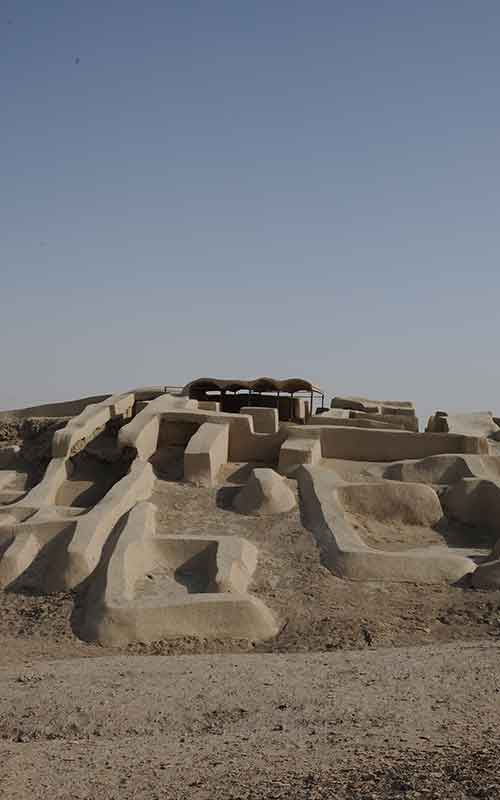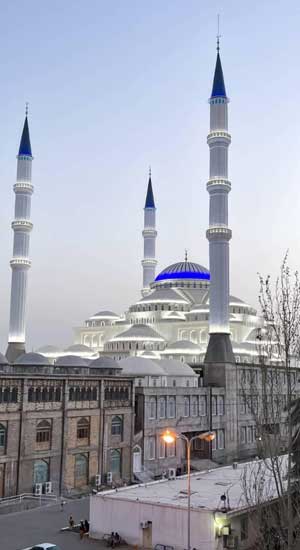SISTAN & BALUCHISTAN PROVINCE
ZAHEDAN CITY
The City of Historical Monuments

A Brief History
Sistan is listed as one of Darius the Great's eastern possessions in the epigraphs of Bistoon and Persepolis. As was already noted, the term Sistan comes from the Central Asian tribe of Saka (also known as Saga or Sagastan), which seized control of this region in 128 BC. The Suren-Pahlav Clan established itself in the province during the Arsacid Dynasty (248 BC to 224 AD). Sistan experienced significant prosperity from the Sassanid era until the early Islamic era.
Sistan was governed by the Sassanids during the rule of Ardashir I of Persia, and in 644 AD, as the Persian empire was on the verge of disintegrating, the Arab Muslims took over.
This region was taken over by the Arabs during the rule of the second Sunni caliph, Omar ibn Al-Khattab, and an Arab commander was appointed as governor. Later, the province's governor was Ya'qub-i Laith Saffari, a renowned Persian king whose descendants ruled this region for many centuries. Baluchestan was ruled by the Daylamids in 916 AD, and then the Seljuqids after it joined Kerman. This region was also governed by dynasties like the Saffarids, Samanids, Ghaznavids, and Seljuqids.
Sistan was conquered by Shah Ismail I of the Safavid dynasty in 1508 AD, and there was more unrest under Nader Shah's rule.
Climate and weather
Sistan and Baluchistan experience long, sweltering, arid summers, mostly clear winters, and windy conditions all year long. The average annual temperature ranges from 32°F to 98°F, with rare exceptions when it falls below 22°F or rises above 103°F.
When to Go to Sistan & Baluchistan?
Mid-May to early September is the ideal time of year to visit Zahedan for hot-weather activities.
Recommended month for traveling to Sistan & Baluchistan Province
SEPTEMBER

Where to Go in Sistan and Baluchistan?
Zahedan
As the capital of Sistan and Baluchistan province, Zahedan is one of the big cities of Iran, which is located in the north of the province. In the old days, this city was known as "Dozdab", but since 1308 AH, it has been called Zahedan. Zahedan ends with Zabul city from the north, Khash city from the south, Afghanistan and Pakistan from the east, and Fahraj city and Lut desert from the west. Most of the residents of this city speak Persian and have a Sistani accent. Of course, many people also speak the Balochi language. Among the attractions of Zahedan, the following can be mentioned:
- Zaranj Zahedan Mosque
- Regional Museum of Southeast Iran
- Zahedan Post and Communication Museum
- Ladiz village
- Our wetlands
- Shah Ali Zahedan Mosque
Chabahar
Chabahar is one of the most important cities of Sistan and Baluchistan province. On the other hand, it is a port city and is important and interesting in terms of economy and tourism in Iran. This city is located in the southeast of the province and is the only ocean port in Iran. This port city is located on the shore of the Makran Sea and the Indian Ocean. Chabahar has so many attractions that it is known as the "Paradise of South Iran". Chabahar city can easily satisfy travelers and tourists and create very good memories of their trip to Sistan and Baluchistan province.
The next advantage of Chabahar City is its favorable and mild climate. As its name suggests, it is a city with a spring climate. Chabahar stands for four springs; A name that speaks of its spring and mild weather. The beautiful and spectacular city of Chabahar with its good weather annually hosts a large number of domestic and foreign tourists. About the city of Chabahar, it is enough that it is the warmest place in the country in winter and the coolest southern port of Iran in summer. In addition to the very favorable and pleasant weather, this city has many attractions among which the following can be mentioned:
- Miniature mountains
- Lipar lagoon
- Chabahar Local Museum
- Dozak Grand Mosque
- Ban Mesiti Caves
- Macrzan tree
- Golafshan
- Gando Protected Area
- Tis Jame Mosque
- Port Goatr
- Pezam Bay
- Peroz Ghat Castle
Iranshahr
Iranshahr is another city in Sistan and Baluchistan province, which was called Fehra in the old days. The arts that are popular in this city are coin Sekedozi and Sozandozi. The people of this city also speak Farsi or Balochi. Iranshahr is located in the central part of the province and there are many rivers and green fields in it, which are suitable places for recreation and sightseeing. In addition to these, other attractions await tourists in Iranshahr, including the following:
- Kenty Spa Spring
- Golfan Abbad Kashi
- Ketukan spa spring
- Bampur River
- Jazmurian Lake
- Bozman spa spring
- Kermanchi Cave
Zabul
Zabul is a very historic city. It has many sights. In the old days, this city was called Segistan, Sejstan (Sistan), and Nimroz. In the past, Zabul was a land full of dunes with sea sediments, and a part of it was located on the path of the Hirmand river. With the dryness of the Hirmand river, the city of Zabul also developed so that it became a settlement in 1314 AH and became the center of Sistan two years later. Among the prominent attractions of Zabul city, the following can be mentioned:
- Rostam Castle
- Kahek Kahzad Castle
- The cultural, research, research, and entertainment complex of Baqiyatollah al-Azam
- Belgian customs
- Ferangi Caravanserai
- Asbads with ponds
- Bank of Iran and England
- Zabul Museum of Anthropology
- Khaja Goltan's tomb
- Dahaneh Gholaman
- Seyyed Gholam Rasool tomb
Khash
Khash is one of the less-known cities of Sistan and Baluchistan province, but it has many beauties. Local people call Khash, Vash. This word means good weather. Khash is a border town in Sistan and Baluchistan province and has both natural and historical attractions. Among the attractions of Khash, the following can be mentioned:
- Jame Khash Mosque
- Doshing mineral spring
- Hyderabad Fort
- Shrine of Morteza Ali
- Taftan mountain range
- Irendan Castle
- Cave of Guatamec
- Chahak Cave
- SeDarya lake
- Sarv Zarbin Sangan
Top Dishes in Sistan & Baluchistan
Kashk-e Zard
Kashk-e Zard is called the food of Zabli warriors. This name is because this food is so nutritional that you will not feel hungry for hours. Kashk-e Zard, which is now popular in Khorasan and can be seen on the tables of Khorasanis, is special for cold autumn and winter days and is served for breakfast. The main basis of this dish is Zaboli curd, which is prepared by the patient and skilled women of Zaboli through a long process. To prepare the food, fry the onion in butter, then add the curd and mix well. Zaboli people add the meat little by little and stir until it is mixed. Kashk-e Zard is served with local bread or so-called tillit.
Zaboli Abgosht
Abgousht is a national dish that is cooked in all parts of the country, but this famous dish has differences in taste depending on the climate of the province. Zaboli Abgousht is similar in cooking method to the common Abgosht that is cooked with meat, tail, onion, potato, salt, and pepper, but the key difference of Zaboli Abgousht is in spice. Achar spice is specific to the people of this country and it is the main ingredient of Zaboli Abgousht. This spice, which is prepared in Sistan itself, is an interesting combination of wheat, cumin, coriander, dill seeds, turmeric, onion, and salt. Achar is made into a circular dough and finally, these circles are hung and dried in front of the sun. This delicious dish, like Kashk-e Zard, is served with a traditional bread called Timosh, which is special for this region and is as thin as paper.
Lendo
The names of dates and the south of Iran are intertwined. Sistan and Baluchistan are also one of the centers of date production in the country, and all kinds of delicious dates are products of this land, so it is not surprising if dates have a special place in the foods of Sistani. Lendo, the delicious food of this country, is a combination of dates, wheat, and sesame. To prepare Lendo, we take the kernels of the dates and put them in a container. In the next step, we roast the wheat and add it to the dates while hot. Then we roast the sesame and add it to our ingredients while hot. Mix the ingredients well and put a heavy object on it so that they stick together completely. After ten hours, Lendo is ready, you can serve it as you like.
Omelet Sozi
Suzi is the name of a local vegetable that grows in Sistan and Baluchistan. To cook this delicious omelet, we first boil Suzi in water. When it becomes a little soft, we drain the water and let it cool a little. In the meantime, fry the onion. Now we mix onion, boiled potato, and Suzi. In another container, we add eggs, salt, and pepper. Pour a little oil on the bottom of a deep dish, add our mixture of ingredients, and in the last step, pour the egg on it. In other regions where Suzi is not available, this omelet is cooked with vegetables such as spinach, but the taste of Suzi is very special and unique.
Digche
Ranching is one of the main occupations of the Baluch people, so many dishes in this region are based on meat, especially goat meat. Digcheh or Tanurcheh is a delicious and authentic food that is served either alone or with rice. To cook Digche, meat is divided into very large pieces. Then each piece is stretched on a skewer made of palm wood and when the oven is ready and the coals are hot enough, they are placed inside the oven until it is cooked completely. Sometimes a container of water is placed in the middle of the oven to soften the meat.
Tabahak
Eid Ghorban is one of the other religious ceremonies and rituals that are important. In ancient times, after sacrificing sheep for Eid, to preserve the mutton, the meat was completely covered with salt and pomegranate powder and placed in front of the sun on a rope to dry. Tabahak is also a popular food during the holy month of Ramadan and belongs to the noble people of the magical region of Makran, It is also served in the surrounding cities of Makran.
Makrani women still prepare meat in the same way for ceremonies and parties. To cook this delicious dish, meat is first boiled in water with salt and pepper. After half an hour, the meat juice is separated and used to cook rice. The meat is fried separately with oil.
Top Souvenirs of Sistan & Baluchistan
Sozan Dozi
The original Iranian art of Sozan Dozi, which has gained worldwide fame today, originates from the province of Sistan and Baluchistan. Balochistan Sozan Dozi is one of the best examples of handicrafts in Iran. it is called "Suchen Dozi" in the local term. The available evidence indicates that this method has been common among these people since the beginning of Islam and reached its peak in the Timurid and Safavid periods. This art is mainly used to decorate women's local clothes.
Seke Dozi
Due to its decorative and ornamental uses, Seke Dozi has a special place after Sozan Dozi in the handicrafts of Balochistan. In this art, raw materials such as small and large mirrors, sequins, fringes and pearls, pearl beads, shell buttons, hardware tape, fabric, coins, and shells are used. Seke Dozi products are mostly used in celebrations, weddings, and marriages. Samples of Seke dozi are put on the camel's neck and it is also used to decorate the bride's bed. Today, this art is also used in the form of an artboard on the wall.
Siah Dozi
Another type of Sozan Dozi is in the Sistan region. This type of sewing is used to decorate the front of the chest and the cuffs of the dress, and they use only black thread, which is usually silk. In Siah Dozi, patterns in the shape of a triangle are sewn on the clothes with the stitches, and chain stitches are sometimes used between them.
Yellow Curd
In the cold days of autumn and winter, Sistani people prepare nutritious food from cereal yogurt products for breakfast, which can be used in a full meal. The preparation method of this curd is different from other curds; Yellow curd is a combination of wheat semolina and dairy products, garlic, dill seeds, green or black cumin seeds, coriander seeds, turmeric powder, some salt, and buttermilk, but rest of the curds are a dairy product. Yellow curd is mixed with onion and meat broth or boiled water. Yellow curd is a fast and delicious food.
Achar spice
Achar is one of the traditional and old spices of the Sistan region. Just like food and food products, which are a part of the identity of each region and representative of their food culture, spices are also a part of the diet of different people. In the meantime, the land of Sistan, as it has special and hidden characteristics, has unique spices. Achar is a local spice that is made from the combination of several ingredients such as wheat, onion, coriander seeds, cumin, etc.
